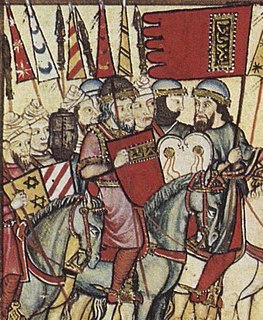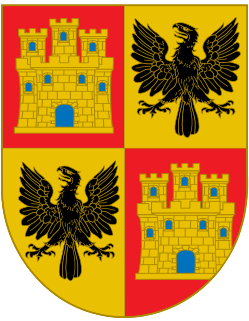
The Battle of Río Salado, also known as the Battle of Tarifa was a battle of the armies of King Afonso IV of Portugal and King Alfonso XI of Castile against those of Sultan Abu al-Hasan 'Ali of the Marinid dynasty and Yusuf I of Granada.

Abu Al-Hasan 'Ali ibn 'Othman, was a sultan of the Marinid dynasty who reigned in Morocco between 1331 and 1348. In 1333 he captured Gibraltar from the Castilians, although a later attempt to take Tarifa in 1339 ended in fiasco. In North Africa he extended his rule over Tlemcen and Ifriqiya, which together covered the north of what is now Algeria and Tunisia. Under him the Marinid realms in the Maghreb briefly covered an area that rivaled that of the preceding Almohad Caliphate. However, he was forced to retreat due to a revolt of the Arab tribes, was shipwrecked, and lost many of his supporters. His son Abu Inan Faris seized power in Fez. Abu Al-Hasan died in exile in the High Atlas mountains.

Abu Abdullah Muhammad ibn Yusuf ibn Nasr, also known as Ibn al-Aḥmar and by his honorific al-Ghalib billah, was the first ruler of the Emirate of Granada, the last independent Muslim state on the Iberian Peninsula, and the founder of its ruling Nasrid dynasty. He lived during a time when Iberia's Christian kingdoms—especially Portugal, Castile and Aragon—were expanding at the expense of the Islamic territory in Iberia, called Al-Andalus. Muhammad ibn Yusuf took power in his native Arjona in 1232 when he rebelled against the de facto leader of Al-Andalus, Ibn Hud. During this rebellion, he was able to take control of Córdoba and Seville briefly, before he lost both cities to Ibn Hud. Forced to acknowledge Ibn Hud's suzerainty, Muhammad was able to retain Arjona and Jaén. In 1236, he betrayed Ibn Hud by helping Ferdinand III of Castile take Córdoba. In the years that followed, Muhammad was able to gain control over the southern cities, including Granada (1237), Almería (1238) and Málaga (1239). In 1244, he lost Arjona to Castile. Two years later, in 1246, he agreed to surrender Jaén and accept Ferdinand's overlordship in exchange for a 20-year truce.
Muhammad II was the second Nasrid ruler of the Emirate of Granada in Al-Andalus on the Iberian Peninsula, succeeding his father, Muhammad I. Already experienced in matters of state when he ascended the throne, he continued his father's policy of maintaining independence in the face of Granada's larger neighbours, the Christian kingdom of Castile and the Muslim Marinid state of Morocco, as well as an internal rebellion by his family's former allies, the Banu Ashqilula.
Muhammad III was the ruler of the Emirate of Granada in Al-Andalus on the Iberian Peninsula from 8 April 1302 until 14 March 1309, and a member of the Nasrid dynasty. He ascended the Granadan sultan's throne after the death of his father Muhammad II, which according to rumours was caused by Muhammad III poisoning him. He had the reputation of being both cultured and cruel. Later in his life, he became visually handicapped, which caused him to be absent from many government activities and to rely on high officials, especially the powerful Vizier Ibn al-Hakim al-Rundi.
Nasr, full name Abu al-Juyush Nasr ibn Muhammad, was the fourth Nasrid ruler of the Emirate of Granada from 14 March 1309 until his abdication on 8 February 1314. He was the son of Muhammad II al-Faqih and Shams al-Duha. He ascended the throne after his brother Muhammad III was dethroned in a palace revolution. At the time of his accession, Granada faced a three-front war against Castile, Aragon and the Marinid Sultanate, triggered by his predecessor's foreign policy. He made peace with the Marinids in September 1309, ceding to them the African port of Ceuta, which had already been captured, as well as Algeciras and Ronda in Europe. Granada lost Gibraltar to a Castilian siege in September, but successfully defended Algeciras until it was given to the Marinids, who continued its defense until the siege was abandoned in January 1310. James II of Aragon sued for peace after Granadan defenders defeated the Aragonese siege of Almería in December 1309, withdrawing his forces and leaving the Emirate's territories by January. In the ensuing treaty, Nasr agreed to pay tributes and indemnities to Ferdinand IV of Castile and yield some border towns in exchange for seven years of peace.
Abu'l-Walid Ismail I ibn Faraj was the fifth Nasrid ruler of the Emirate of Granada on the Iberian Peninsula from 1314 to 1325. A grandson of Muhammad II on the side of his mother Fatima, he was the first of the lineage of sultans now known as the al-dawla al-isma'iliyya al-nasriyya. Historians characterise him as an effective ruler who improved the emirate's position with military victories during his reign.

Abu al-Hajjaj Yusuf ibn Ismail, known by the regnal name al-Muayyad billah, was the seventh Nasrid ruler of the Emirate of Granada on the Iberian Peninsula. The third son of Ismail I, he was Sultan between 1333 and 1354, after his brother Muhammad IV was assassinated.
Abu Abdullah Muhammad ibn Ismail, known as Muhammad IV, was the ruler of the Emirate of Granada on the Iberian Peninsula from 1325 to 1333. He was the sixth sultan of the Nasrid dynasty, succeeding to the throne at ten years old when his father, Ismail I, was assassinated.
Muhammad VII was the twelfth Nasrid ruler of the Muslim Emirate of Granada in Al-Andalus on the Iberian Peninsula. He was the son of Yusuf II and grandson of Muhammad V. He came to the throne upon the death of his father. In 1394, he defeated an invasion by the Order of Alcántara. This nearly escalated to a wider war, but Muhammad VII and Henry III of Castile were able to restore peace.
Abu Sa'id Uthman II was the 10th Marinid sultan of Morocco, reigning from 1310 to 1331. A younger son of Abū Ya'qūb Yusuf an-Nasir, Abū Sa'īd 'Uthmān succeeded his nephew Abū al-Rabï' Sulaymān as Sultan of Morocco in November 1310, at the age of 33.
Abu Yaqub Yusuf an-Nasr was a Marinid ruler of Morocco. He was the son of Abu Yusuf Ya'qub, whom he succeeded in 1286. He was assassinated in 1307.

Peter of Castile, in Spanish Pedro de Castilla, was an infante of Castile, a younger son of King Sancho IV and his wife María de Molina. He held the lordships (señoríos) of Cameros, Almazán, Berlanga, Monteagudo and Cifuentes and was the majordomo of his brother, King Ferdinand IV of Castile. During the minority of his nephew Alfonso XI, he shared the regency of Castile with his mother and uncle, John el de Tarifa, between 1313 and his death.
The sixth siege of Gibraltar in 1411 was the only occasion on which control of Gibraltar was contested between two Islamic powers. After the failed fifth siege of Gibraltar in 1349–50, which ended with the death of King Alfonso XI of Castile from bubonic plague, the Kingdom of Castile was preoccupied with the Castilian Civil War and its aftermath. In 1369, Sultan Muhammed V of Granada took advantage of the Castilians' distractions and in the siege of Algeciras (1369) he seized the city of Algeciras, on the west side of the Bay of Gibraltar, which Alfonso XI had captured in 1344. After razing it to the ground he made peace with Henry II, the winner of the civil war. The truce was renewed by Henry's successors John I and Henry III. At some point during the truces, control of Gibraltar was transferred from the Marinid dynasty of Morocco, which had held it since 1333, to the Granadans. It is not clear why this happened; it may have been as a condition of the Granadans assisting the Marinids against rebels in Morocco.

Abu Said Uthman III, was Marinid ruler of Morocco from 19 March 1398 to 1420, the last effective ruler of that dynasty. He ascended to the throne at the age of sixteen. He succeeded his brother, Abu Amir Abdallah ibn Ahmad. His forces were involved in an unsuccessful attempt to acquire Gibraltar from the Emirate of Granada in 1410. In 1415 the Portuguese seized the port of Ceuta. Abu Said Uthman III failed in an attempt to recover Ceuta, and was shortly after assassinated. His vizier gained control of the kingdom, establishing the Wattasid dynasty of rulers of Morocco.

The Battle of Sierra Elvira, also called the Disaster of the Vega de Granada, was a battle of the Spanish Reconquista fought near the city of Granada on 25 June 1319. The battle was fought between the troops of the Emirate of Granada and those of the Kingdom of Castile. The battle resulted in a catastrophic defeat for Castile.
The Siege of Almería was an unsuccessful attempt by Aragon to capture the city of Almería from the Emirate of Granada in 1309. Almería, a Mediterranean port in the southeast of the emirate, was the initial Aragonese target in a joint Aragonese-Castilian campaign aimed at conquering Granada. The Aragonese troops led by their King James II arrived on 11 August, blockading the city and employing siege engines. The city, led by governor Abu Maydan Shuayb and naval commander Abu al-Hasan al-Randahi, prepared for the siege by strengthening its defenses and stockpiling food. Throughout the siege, both sides exchanged shots from siege engines and engaged in fields battles and skirmishes with varying results. James ordered multiple unsuccessful assaults. A Granadan relief column under Uthman ibn Abi al-Ula arrived nearby in September and harassed the besiegers.
Abu Said Faraj ibn Ismail was a member of the Nasrid dynasty of Granada, who was a close advisor to Sultan Muhammad II and Muhammad III and served as the governor of Málaga between 1279 and the early 1310s. He was born in 1248 to Ismail ibn Nasr, governor of Málaga and brother of Sultan Muhammad I. After Ismail's death, the Sultan brought the young Abu Said to court, where he became friends with his cousin, the future Muhammad II. When the latter became Sultan, Abu Said became his advisor on economic and military policies. He married Muhammad II's daughter Fatima, and in 1279 he was appointed as the royal governor in Málaga. The city—the realm's most important port—had just recently been recovered by the crown after a rebellion by the Banu Ashqilula since 1266 followed by a short occupation by the Marinids of Morocco since 1278. He implemented policies to pacify the population and improved the region's economic condition, as well as embarking on the construction of ships to strengthen the Granadan navy. As governor, he also led Málaga's troops in various campaigns on the Iberian Peninsula, including against rebels and against the Marinid Sultanate.
Abu Sa'id Uthman ibn Abi al-Ula was a Marinid prince who led an unsuccessful rebellion aiming to capture the throne, and fled to the Nasrid Emirate of Granada in its aftermath. There he served as the Commander of the Volunteers of the Faith of Granada, and became one of the most important political figures of the Nasrid realm.










